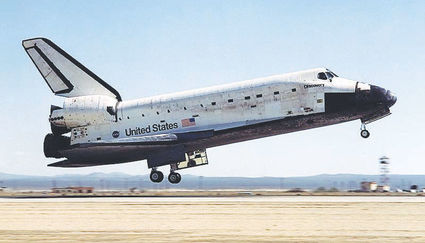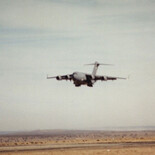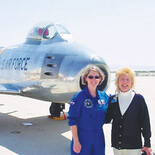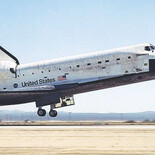Shuttle Pilot and Shuttle Commander Pamela Melroy
Short Flights
Retired Air Force Col. Pamela A. Melroy, commanded the STS-120 Space Shuttle mission that delivered the Node 2 connecting module to the International Space Station (ISS). She was an active member of the Antelope Valley Ninety-Nines chapter.
The Ninety-Nines, Inc. is an International Organization of Licensed Women Pilots from thirty five countries.
The successful launch on Oct. 23, 2007 aboard Orbiter Discovery was the 120th space shuttle flight; the mission duration was fourteen days. But let me back up a few years.
Pam became a member of the Antelope Valley Ninety-Nines when she attended the Air Force Test Pilot School at Edwards AFB in 1991. Upon graduation, she was assigned to the C-17 Combined Test Force and served as test pilot until she was selected for astronaut training. I often saw her doing crosswind landings at Mojave with the C-17. It made me feel good that she was only 5' 2" and was the shortest person to fly the big cargo plane.
In space shuttle orbiter Discovery (STS-92), Lt. Col. Pamela Ann Melroy, USAF, became the third woman to make a rookie flight into space as pilot on Oct. 11, 2000. A group of women from the Antelope Valley Ninety-Nines were invited to attend the launch. Really mind-boggling to see and feel the power of the launch. I'll never forget it!
STS-92 Discovery was part of a series of historical assembly flights of the International Space Station (ISS). Pam's job was to keep the shuttle systems up and running, help the Commander fly the rendezvous with the ISS and keep watch as the Z1 truss was removed from the shuttle bay and attached to the ISS, monitor all procedures for landing, plus, deploy the landing gear and drag chute.
STS-92 made a flawless landing at Edwards AFB. It was wonderful to actually see the launch and also witness the landing!
Pam was also pilot on STS-112 Atlantis, which was actually the 111th space shuttle mission and delivered the Integrated Truss Assembly S1 (Starboard Side Thermal Radiator Truss) and the Crew Equipment Translation Aid (CETA) Cart to the Space Station with the robotic arm of the shuttle.
Translated, Pam and crew attached the 45-foot long, 15-foot wide, 31,000 pound S1 Truss to another truss that was delivered to the ISS earlier by STS-110.
At a Lockheed-Martin Leadership Association dinner held the night before the Jackie Cochran celebration, Melroy explained, "It's like a giant erector set." She further described adding parts to the space station, "It's like a video game using the robotic arm to lift the truss out of the shuttle and onto the space station." Pam said. "You just watch the monitor screen the whole time and line everything up just like in the simulator."
"It is easy to get disoriented when walking in space," said Pam. "You always feel like you are falling if you look down." She added, "So, I told my fellow astronauts not to look down, but they always did!"
"They would spend ten hours in the spacesuit and would be exhausted when they came back aboard," Pam explained. "Working in space is like movement under the water and takes a lot of energy."
I remember Pam describing what it is like to enter the atmosphere at Mach-22 and land the shuttle at 205 knots! Hard for a Cessna pilot to ever imagine!
This photo of Pam and me (above), standing in front of my husband Al's F-86 Sabre, was taken at Edwards in May 2003 while celebrating the 50th anniversary of Jackie Cochran breaking the sound barrier.
Melroy, was the second woman to command a space shuttle. Marine Corps Col. George D. Zamka served as pilot
STS-120 was the 23rd shuttle mission to the International Space Station, and launched an Italian-built U.S. multi-port module for the station.
Expedition 15/16 Flight Engineer Clayton Anderson returned to Earth from the space station aboard shuttle mission STS-120. That flight carried his replacement, Daniel Tani, to the station.
Here are some education statistics for all of our local future astronauts to emulate. Pam graduated from Bishop Kearney High School, Rochester, New York, in 1979; earned her Bachelor of Science degree in physics and astronomy from Wellesley College in 1983; and obtained her Master of Science degree in earth & planetary sciences from Massachusetts Institute of Technology in 1984.
See you on our next flight!









